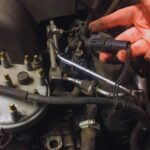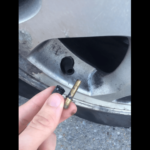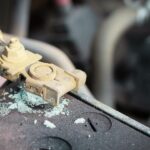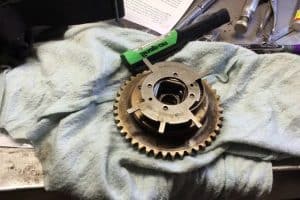A car engine’s poor performance can sometimes be attributed to too much or too little valve clearance. If the valves are not properly seated, fuel and compression leaks will also result, leading to rough engine performance. This problem can be solved by valve lapping.
Valve lapping is the process of sanding down the valves’ surface and the valve head where the two make contact with each other.
Engine valves allow air and fuel inside the cylinders and also let the unburned fuel escape in the exhaust. The valve head is the engine part that holds the valves to the camshaft.
You can perform this lapping process on engine parts that require very tight tolerances of parallelism, flatness, finish, or thickness.
It is a process that needs different surface finishing procedures in which loose abrasive powders are used as grinding agents. The grinder is usually run at low speeds.
Read on to learn more about valve lapping car engines, including how to lap valves. I’ll also describe a popular valve lapping tool and valve lapping kit that you can use.
Valve Lapping

In general, people perform lapping on the valves and seats to polish them and correct their imperfections.
This process eliminates minor deformities or irregularities in the mating surfaces of the valve and valve seats. It is done to produce a tighter seal between the valves and their seats.
The various work done on the mating surfaces is actually to provide the damaged surfaces a smooth finish by using loose abrasive powders as grinding agents applied at normally slow speeds.
After this process, the expectation is that there will be very tight tolerances in parallelism, flatness, finish, or thickness between the valves and their seats.
The internal combustion engine works by achieving a specific compression ratio. This ratio differs from engine to engine. An engine burns an air to fuel mixture compressed to a specific volume determined by its compression ratio.
Proper air to fuel mixture must be present in the combustion chambers (engine cylinders) to ensure complete fuel burning and to reduce carbon emissions in the exhaust.
But if there is a leak in the valve seating, the air to fuel mixture will change, and improper combustion will result. This will ultimately result in erratic engine performance.
Therefore, you have to tightly seal the valves to ensure a fully sealed combustion chamber during the combustion process. If the seal is compromised, you can perform valve lapping.
You can do valve lapping by applying a compound paste, which is practically a mixture of fine-grain sand and oil. Apply the paste on the edges of the valve, then on the valve’s head.
This lapping process will create a better seal between the head and the valve and prevent gases from escaping while the engine cylinders are on their compression stroke.
The increased contact area allows for more dissipation of the heat from the valves to the head. It will prevent valves from burning too.
Purpose of Valve Lapping – A Closer Look
Earlier, we discussed what valve lapping is. Now, let’s discuss the purpose of valve lapping.
- The primary purpose of valve lapping is to achieve a good, if not perfect, seat for the valves.
- The process will produce finer surfaces, correct minor imperfections, produce closer fits and close or tight tolerances between the engine valves and their corresponding valve seats. These engine parts are all enclosed inside an internal combustion engine cylinder head assembly.
- It is important for good engine performance that the entry of the fuel and air mixture into the combustion chambers be done at the right time. In other words, this air-fuel mixture must not be allowed inside the burning chambers until it is the right time.
- A good seat also means there will be no compression leaks. If there are imperfections in the valves’ surfaces and their seats, there will be compression leaks. This will produce engine efficiency reduction.
If there are imperfections in the valve’s sealing and seats, this air-fuel mixture can enter the combustion chambers anytime. This will result in reduced engine performance.
This is why valve lapping is one of the remedies in improving the efficiency of the car engine. Examining the quality of valve seating is one of the things that can be done to check engine performance.
If it is found to be the culprit, the valves’ lapping is done to restore or improve engine performance.
Additionally, the valves’ lapping must be performed if the valves have been removed during engine repair or maintenance. If this is not done, backfires, misfires, and even broken valves, could be consequences.
Benefits of Valve Lapping
There are some decided benefits to lapping your car engine’s valves regardless of whether you’re using a small engine valve lapping tool. The actual process should not take that long, but the benefits you can enjoy after doing it are matchless.
Here are some of its major benefits:
- It will create a better seal between the valve and the head. This will prevent the air and fuel mixture and gases from escaping the combustion chambers during the engine’s compression stroke.
- There will be an increase in the contact area between the valve and the head. This will allow for more heat dissipation from the valve to the head. It will also prevent the burning of valves.
- Lapping valves is one way to improve the performance of car engines. If you experience a reduction in your car’s engine performance, lapping the engine’s valves may remedy the problem.
- As the engine improves its performance, it will improve its fuel efficiency. The burning of fuel will be improved, and there will be less unburned fuel and lesser smoke going out to the exhaust.
How Does Valve Lapping Work? What Is Valve Lapping Exactly?
Valve lapping is usually performed using the following:
- Valve lapping sticks,
- A power tool, or
- A special valve lapping machine.
These are the valve lapping tools for small engines.
The first two methods are done manually. There is now a better lapping valve method, which utilizes a Valve Lapping Machine for Internal Combustion Engine.
In lapping valves, it is important to remember that lapping does not replace valve jobs. However, it helps in improving the compatibility of the mating surfaces. It is good to have machines to do the job now. But it is also good to know how to lap valves manually since it solves the problem.
It is also worth noting that grinding can produce an air-tight finish for the valves and their valve seats. But the purpose of lapping is to check if the grinding was done properly.
For engines with cylinder heads rebuilt by an engine repair shop, a machine will usually put a specific bevel on the valves and seats. But this process does not guarantee a good seal between the valves and their seats.
So a good engine rebuilder will always check if everything seats correctly before finally assembling the engine parts altogether. If the engine builder has properly ground the valve faces and the valve seats, it will only take a short time to lap each valve.
Again, what is valve lapping? Valve lapping is the process when you sand down the surface and head of the valves. By doing this, the engine valves can allow air and fuel inside more effectively and let the unburned fuel escape efficiently.
How to Lap Valves
Valves with tight seals should be air and liquid tight. When working with the engine, its cylinder head should be upside down on the workbench.
It should be propped so that the combustion chambers are flat. If liquid seeps right through into the port, the valves are not properly seated. They need lapping.
To lap engine valves, you will need the following tools:
- Valve grinding compound
- Valve lapping tool
- Engine oil
- Clean rag or cloth or wire
- Protective eyewear and gloves
1. Clean the Valves and Valve Stems
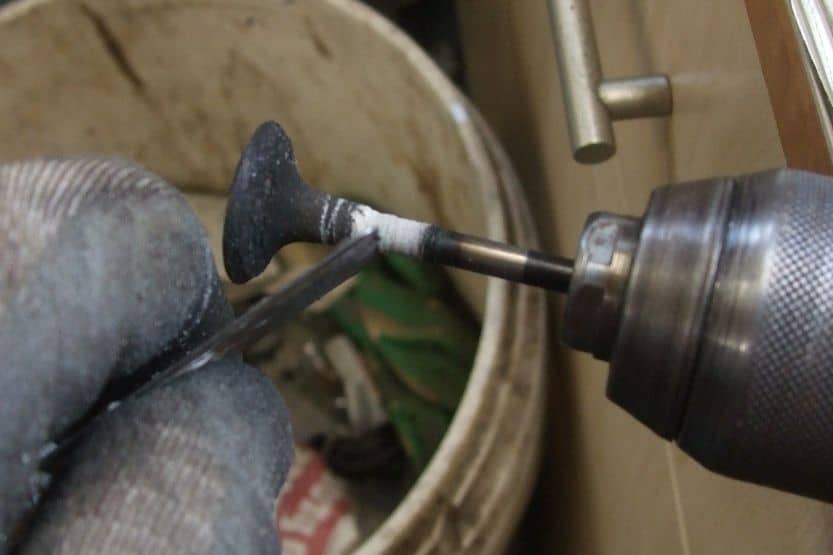
Wear protective gloves and goggles. Check the seal on one head that has just come off the car. Clean and take the gunk and carbon off the head, the sealing area, and the stem with a rag, cloth, or a wire. Ensure that no dirt is left in the valve stem or the valve guide.
This cleaning process may take longer than the actual lapping of the valve. Inspect the valve seat for any uneven seal or pitting. It should be resurfaced if it is uneven or damaged.
2. Oil the Valve Stem
Apply a light coat of engine oil to the valve stem. Then put it in the guide. You can use a 5/39 W oil, although it is not really that important.
3. Apply the Grinding Compound
Apply the grinding compound on the edge of the valve.
4. Stick the Rubber Cup
Stick the rubber cup of the valve lapper on the valve face and start lapping by following the procedure below:
- Put the valve in the cylinder head.
- Wet the suction cup on the lapper.
- Stick it on the valve face.
- As soon as the lapper grabs the valve, start the lapping process.
- Put the lapper in between your hands.
- Rotate the tool back and forth at a moderate speed.
- Apply the pressure downward but use light pressure only. Your motions should be as if you are trying to start a fire with a stick.
- Lift the valve periodically and rotate it 180 degrees repeatedly. This will ensure that the grinding compound is being spread evenly. Do not let the lapping compound get into the valve guide.
- Monitor your progress. It would be best to look for a consistent ring of grey color on the valve and the valve seal. There should be no high spots or break in the grey ring.
- When you sense and hear that the grinding compound is losing its cutting capability, wipe it off and check the surface.
Both surfaces should have a dull grey color if you are already done. The width of the ring should also be even on both surfaces. The even ring should be around the valve but not necessarily in the middle. You need to see the same consistent grey line on the seat and the valve.
Once you are finished lapping one valve and its valve seat, repeat the process for the other remaining valves and valve seats – if they don’t have proper sealing.
Valve Lapping by Machine

Manual valve lapping can be prone to error. That is why engine rebuilders have developed a machine that will do it automatically. The “Valve Lapping Machine for Internal Combustion Engines” is a recent technological development. It is designed to replace the manual method of lapping valves.
This machine utilizes a fully automated but still mechanical system that can execute two different motions in two different directions, which were previously done by hand.
Compared to the manual method, this valve lapping machine is more effective because of the human factor, and consequently, human error is effectively removed from the process.
Valve Lapping Tool / Valve Lapping Kit
If you are looking for a valve lapping kit or valve lapping tool for small engines or big engines, there are many options available on Amazon.
One of your options is the WINTOOLS Valve Lapping Pro Tool Attachment Car Repair Tool Kit 4 Suction Plates:
Click here to see it on Amazon.
This valve lapping tool for small engines comes with an 8 mm. shaft and 4 suction cups of 20, 30, 35, and 45 mm. sizes. You can work them up to speeds ranging from 1000 rpm to 1250 rpm. They can change direction automatically, which facilitates the insertion of valves.
Another lapping tool you can use is the Powerbuilt 648448 2 pc Double Cup Valve Grinder.
Click here to see it on Amazon.
This is a set of valve grinders that you can use for valve lapping. The cups are made of high-quality synthetic rubber. They are built to last and are chemically resistant.
Conclusion – Valve Lapping
Lapping the valves of an internal combustion engine involves sanding down the valves’ surface and the valve head where the two are contacting each other. This process is required if there are imperfections or damages to the valves and the valve seats.
Air and fuel enter the engine cylinders through the valves. The unburned fuel also flows out of these valves. If the valves and their corresponding seats are damaged or imperfect, air and fuel may leak as the engine goes into its compression stroke.
The engine’s performance will be adversely affected. This is why valve lapping is important.




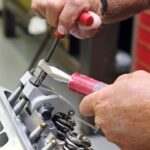

![Driving With a Bad Purge Valve [What Happens? Signs and Symptoms] driving with a bad purge valve](https://roadsumo.com/wp-content/uploads/2022/02/driving-with-a-bad-purge-valve-150x150.jpg)
